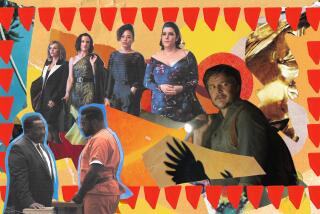‘Hobbit: Desolation of Smaug’: Did it pursue the best strategy?
- Share via
Almost as intriguing as the goings-on in Middle Earth has been the drama surrounding the “Hobbit” franchise itself. There was the fact that star director Guillermo del Toro walked off after a year of work. There’s been a long-running lawsuit.
And then, of course, that when it was finally almost ready last year, the production grew so expensive — er, epic — that director Peter Jackson and studio New Line saw fit to take what they had and slice it into three movies. That enabled more revenue and a longer life for the franchise, which will now span three holiday seasons through 2014.
The second of those movies, “The Hobbit: The Desolation of Smaug,” performed decently this past weekend. It garnered $73.6 million. That’s good enough, if not necessarily good. The receipts make “The Hobbit” the ninth-best opening of the year--fine for, say, a midbudget comedy but a little more wobbly for an effects-driven holiday sequel from one of the most popular directors on the planet, adapting one of the most popular books on the planet.
PHOTOS: ‘The Hobbit: Desolation of Smaug’ - 60 images from Middle-earth
More to the point, the opening-weekend total is about 12% lower than the $84.6 million of the first film. “The Hobbit: An Unexpected Journey,” which opened about the same time last year. Almost every successful sequel adds to the original as new fans come along, sometimes spectacularly so. (The second “Lord of the Rings” movie opened to 30% more than the first film.)
Internationally things were only slightly better for “Hobbit”: The film was down from its roughly $170 million last year to about $135 million this year (though it opened in seven fewer markets, so in comparable markets it was up 3%, a modest if hardly earth-shaking gain).
All of which leads to the question — did New Line do the right thing by carving out a third film? Or should it have grouped some of what happens in “Smaug” in the first movie and some in next year’s finale and gone with the original two-film plan?
Doing a hard-core cost-benefit on all of this is tricky, since it’s tough to know how much a third film cost. The total price tag for the three movies is pegged between $500 million and $600 million, but given the fixed costs, a third movie did not actually cost a third of that total. Equally tough is figuring out if some of the “Journey” filmgoers who sat out last weekend did so because they knew this wasn’t the end of the series — but it stands to reason they would.
Culturally, though, there’s certainly an argument that three is lesser than two, especially since the building momentum we saw on “Lord of the Rings” has now given way to the yawning oh-another-movie-ness of “The Hobbit.” People saw it, but was the water-cooler talking about it?
VIDEO: Ian McKellen talks ‘scruffy’ Gandalf in ‘The Hobbit’
Franchises like not only volume but consistency, a new movie that comes out the same time every year. Look at how “Twilight” and “Harry Potter” mined that later in its life cycle. But when it comes to something as beloved — and as long-in-development — as “The Hobbit,” there’s a case to be made that less is more. Seeing characters too regularly deprives it of its uniqueness; what’s gained in the front-of-mind frequency department is lost in the magic rarity department. It’s hard for something to feel like an event when it always seems to be hanging around.
Sure, “Lord of the Rings” did this, but that film a) came when it was still novel to see Tolkien on the screen and b) is a property based on three volumes to begin with, not one book stretched out to its triplicate breaking point.
(A colleague of mine, a major Tolkien-phile, does offer an alternate theory—that the first “Hobbit” movie is the one that contained too much exposition and could have been folded into this considerably meatier film; the lower box office for “Smaug,” he proposed, is attributable to a lingering taste some fans had after that first movie.)
Cultural cachet is ineffable, and has much to do with when something hits as what it is that’s hitting. This movie may yet have a long life, and don’t underestimate the possibility of a strong rebound with the third film.
Still, one can’t help thinking there’s something to be said for, when it comes to film fantasies, too much of a good thing is a bad thing. “The Hobbit” has devoted fans, and you can release a new movie at the same time every day from now until kingdom come and still attract them. Many others of us, though, would prefer a more selective approach, less ribrock predictability and more of an unexpected journey.
ALSO:
Movie moguls do battle over ’Hobbit’s’ golden hoard
Box office: ‘The Hobbit: The Desolation of Smaug’
Movie review: ‘The Hobbit: The Desolation of Smaug’
Follow me on Twitter at https://twitter.com/ZeitchikLAT
More to Read
Only good movies
Get the Indie Focus newsletter, Mark Olsen's weekly guide to the world of cinema.
You may occasionally receive promotional content from the Los Angeles Times.










